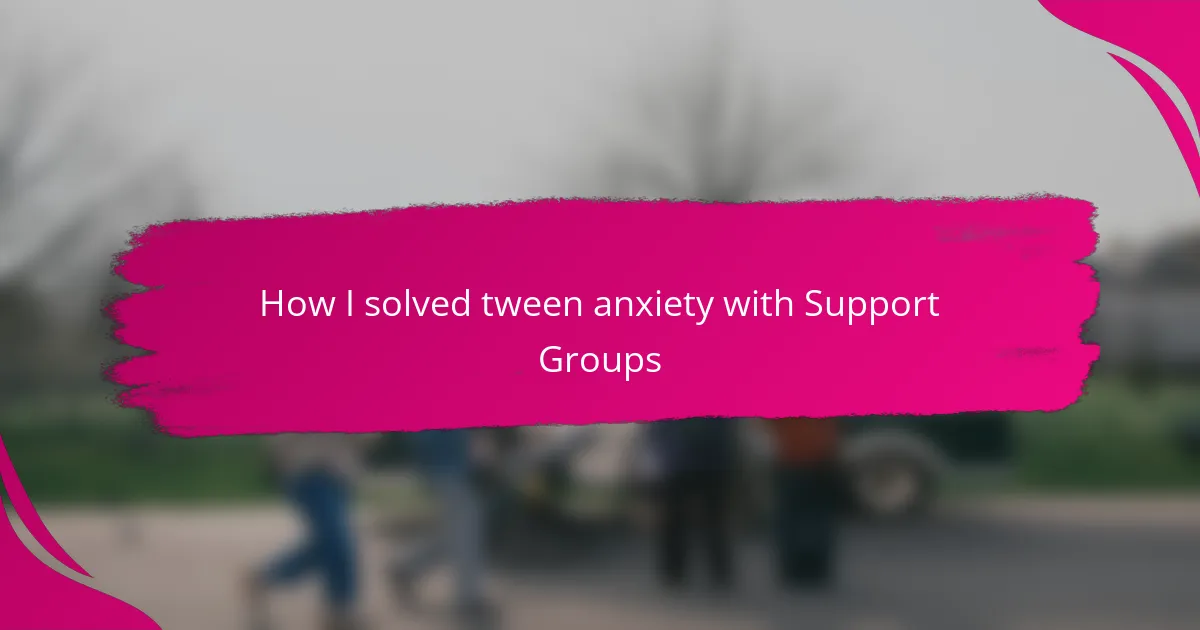Key takeaways
- Tween anxiety often manifests through physical symptoms and changes in behavior, requiring attentive observation from parents.
- Support groups provide crucial community and coping strategies, helping both tweens and parents feel understood and less isolated.
- Creating a safe space with open communication and acceptance encourages tweens to share their feelings without fear of judgment.
- Practical tools, like breathing exercises and casual check-ins, can empower tweens to manage their anxiety effectively.
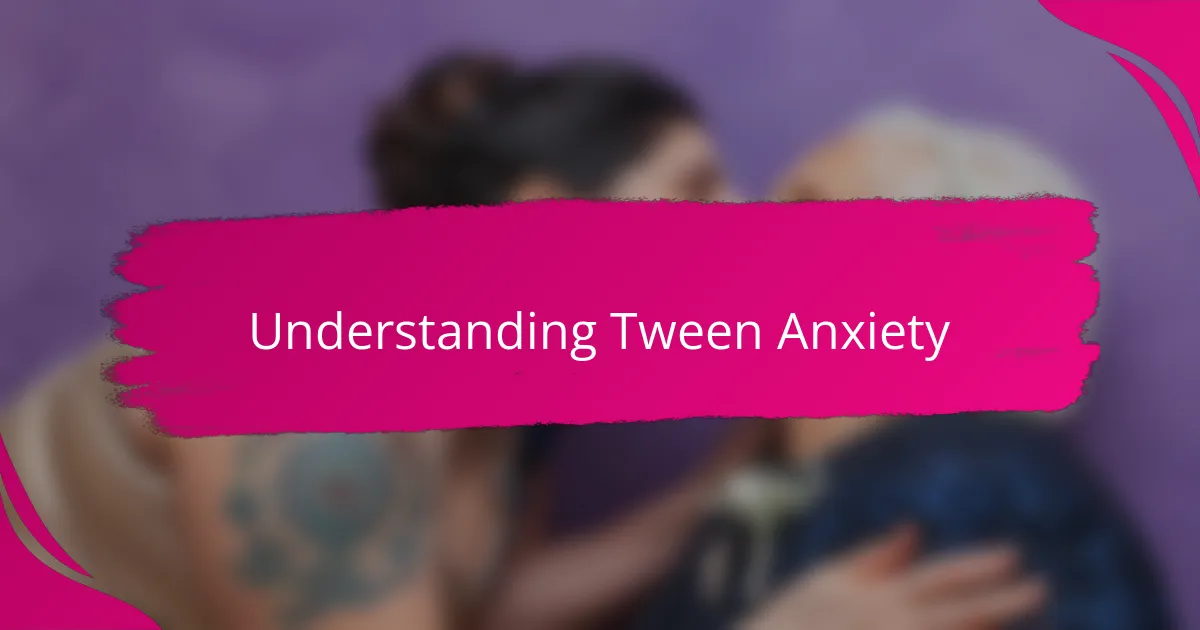
Understanding Tween Anxiety
Tween anxiety isn’t just occasional nervousness; it’s often a persistent feeling that something is wrong, even when everything seems fine. I remember watching my own child struggle with sleepless nights, unsure if it was just a phase or something deeper. Have you ever noticed how something small, like a forgotten homework assignment, can spiral into a giant worry for tweens?
What’s tricky is that tweens are caught between childhood and adolescence—they want independence but still need reassurance. This tug-of-war can create internal tension that’s hard for adults to fully grasp. I found myself asking, “Is this typical worrying or something that needs more attention?” It taught me to listen carefully, not just to their words but to their feelings.
Anxiety in tweens can manifest in surprising ways: irritability, reluctance to go to school, or physical symptoms like stomachaches. When I saw these signs, it was clear anxiety wasn’t just in their head; it was affecting their daily life. Understanding this made me realize why support groups became a lifeline—not just for them, but for me as a parent trying to help.
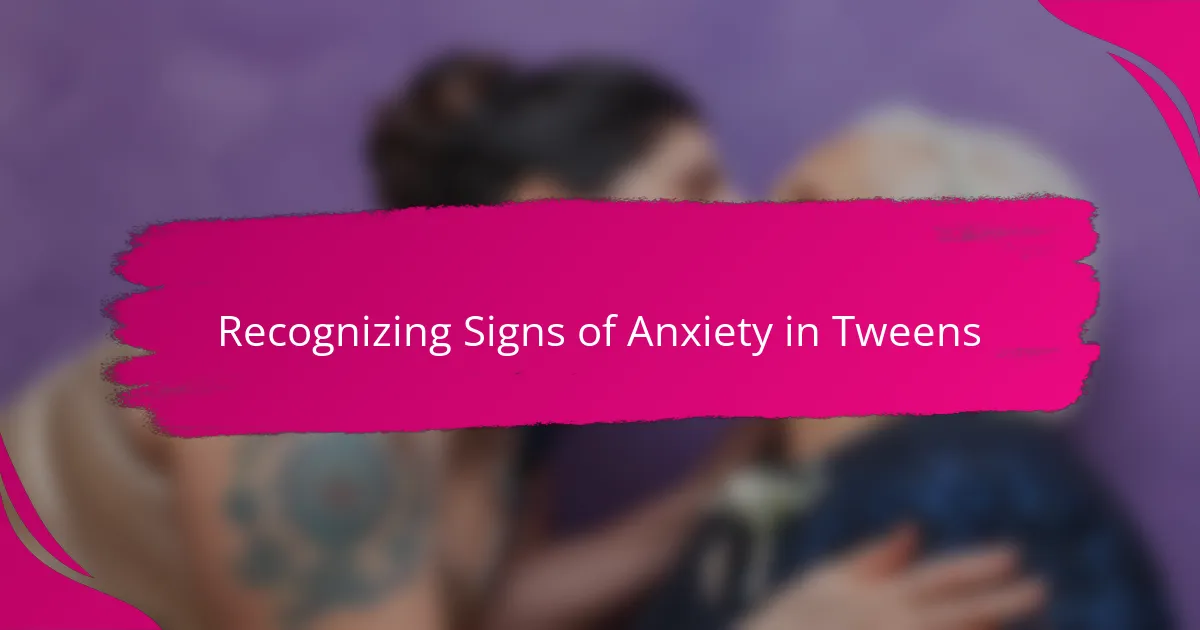
Recognizing Signs of Anxiety in Tweens
Sometimes the signs of anxiety in tweens are subtle—like a sudden withdrawal from family activities or constant fidgeting that wasn’t there before. I remember one afternoon when my child, usually so chatty, just sat quietly, avoiding eye contact, and it hit me that something wasn’t right. Have you ever felt that uneasy moment when your gut tells you they’re hiding something deeper?
One thing I’ve learned is that anxiety often wears disguises. It might look like frustration over small tasks or unexplained mood swings that leave you puzzled. Watching these changes closely helped me connect the dots, realizing these weren’t just typical tween moodiness but real signs calling for support.
Physical complaints, like frequent stomachaches or headaches, can sometimes be the only clues tween anxiety gives us. When my child mentioned a sore tummy almost every morning before school, I wondered if it was just nerves or something more. It made me appreciate how important it is to take those symptoms seriously, even when there’s no obvious cause.
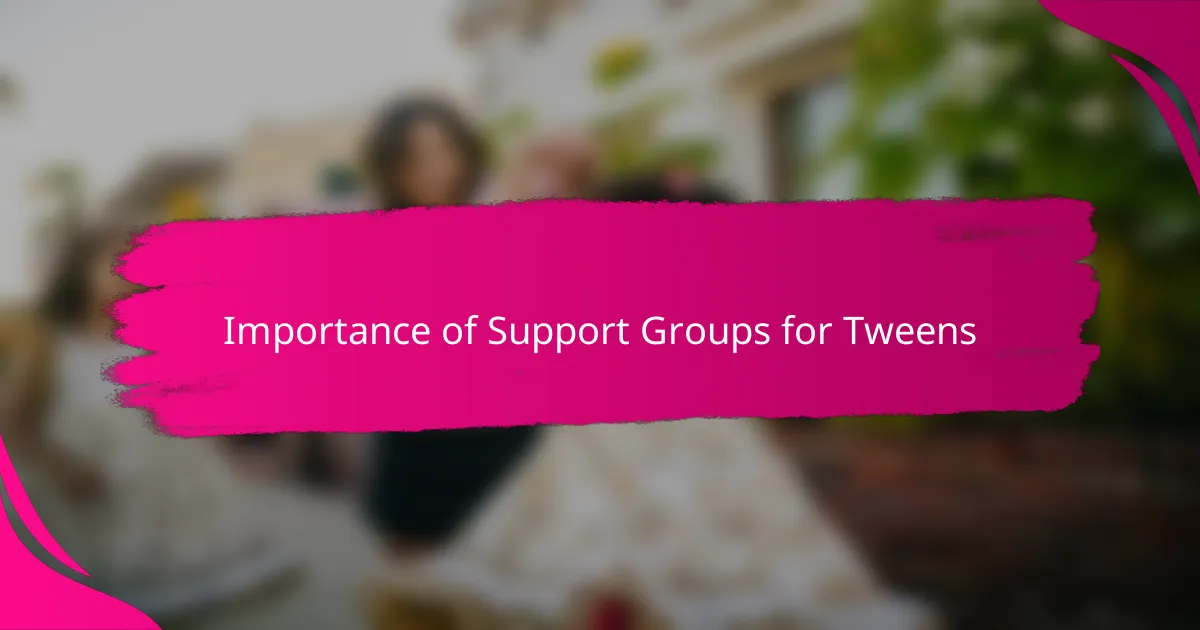
Importance of Support Groups for Tweens
Support groups turned out to be a game-changer in our journey with tween anxiety. I was surprised by how opening up with other parents and kids who truly “got it” created a sense of relief I hadn’t expected. Isn’t it comforting when tweens realize they’re not alone in feeling overwhelmed, and that others understand exactly what they’re going through?
What struck me most was seeing my child’s confidence grow in these groups. The safe space to share fears without judgment helped them feel heard and accepted, which made a noticeable difference at home and school. Have you noticed how important it is for tweens to find that sense of belonging, especially when anxiety can make them feel so isolated?
Support groups also provided practical tools that made a real impact. From simple breathing exercises to stories of success from peers, these experiences helped normalize anxiety and offered coping strategies I hadn’t considered before. It taught me that sometimes, healing happens best in community, not just in solitude.

How to Find the Right Support Group
Finding the right support group felt overwhelming at first—I wondered, where do I even start? I found it helpful to ask other parents, teachers, or counselors for recommendations, because sometimes the best groups aren’t the ones that shout the loudest online but those quietly trusted by people you already know. Have you ever noticed how personal referrals often lead to the most meaningful connections?
I also realized that matching the group’s approach with my child’s personality made all the difference. Some groups focus on guided activities, while others emphasize open conversation or parent involvement. Watching my child respond better to certain settings helped me figure out what truly felt safe and supportive for them.
It’s worth considering the group’s size and structure, too. Smaller groups felt more intimate and less intimidating for my tween, while larger gatherings sometimes made sharing harder. Have you thought about whether your child would thrive more in a cozy circle or a bigger community? From my experience, that choice matters more than I initially expected.
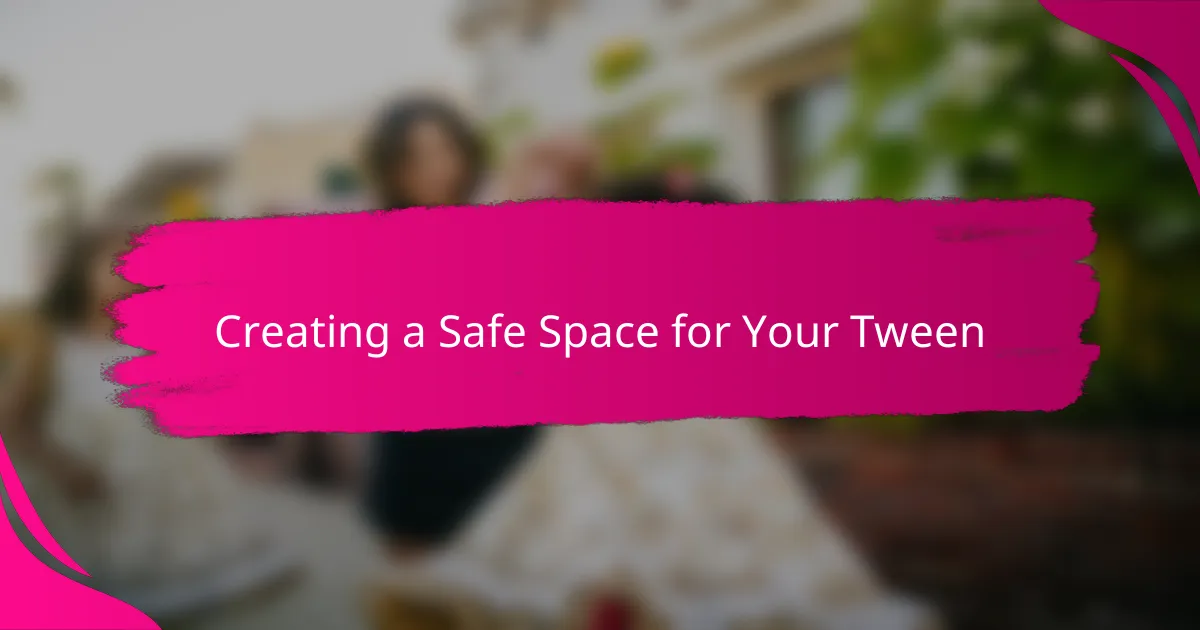
Creating a Safe Space for Your Tween
Creating a safe space for your tween means more than just a quiet room—it’s about building trust so they feel comfortable sharing what’s on their mind. I remember setting aside time each evening just to talk, no distractions allowed, and slowly, my child started opening up about worries I never knew they had. Isn’t it amazing how simply showing up with patience can make such a difference?
Safety also comes from acceptance without judgment. When my tween expressed fears or embarrassing thoughts, I made sure to listen without minimizing or rushing to fix things. Have you noticed how quickly tweens shut down if they think their feelings will be dismissed? Creating that kind of unconditional support isn’t always easy, but it’s essential.
Physical comfort matters too—soft lighting, cozy seating, and a calm atmosphere helped my child feel at ease before opening up. Even small gestures, like having their favorite blanket nearby or a stress ball to hold, contributed to a sense of security. What little things could you add to your home to make it a true refuge for your tween?
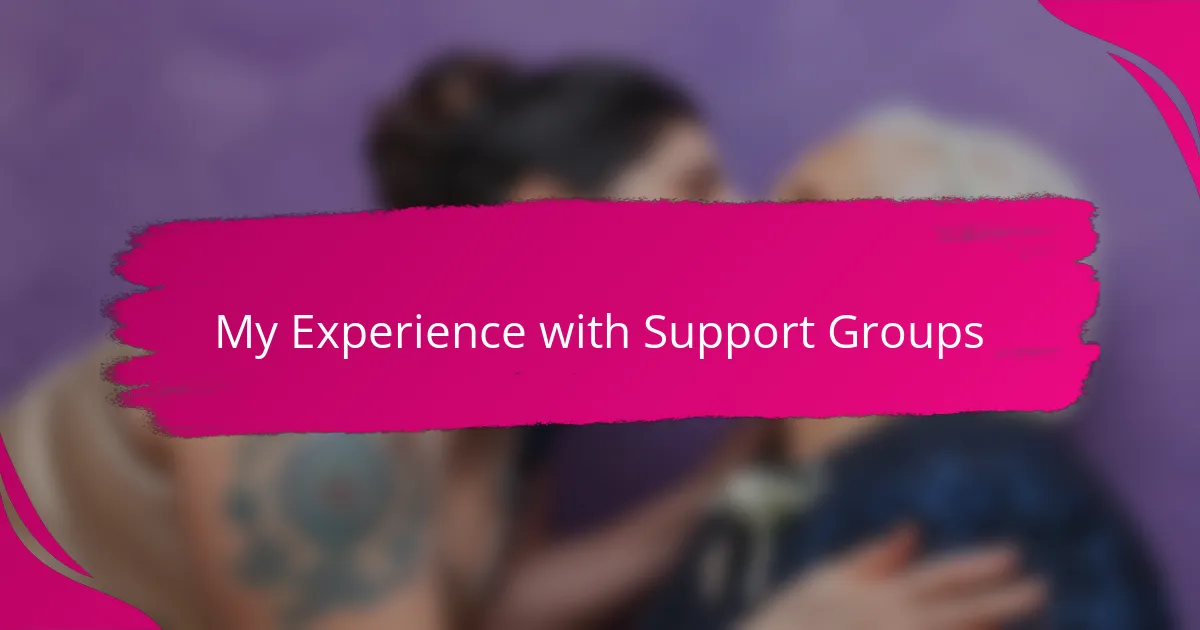
My Experience with Support Groups
Joining a support group felt like stepping into a room full of understanding strangers who quickly became a lifeline. I remember the relief washing over me when parents shared their own struggles—it made me feel less alone in this overwhelming journey. Have you ever found comfort just in knowing others are walking the same path?
What struck me most was watching my child slowly let their guard down among peers who didn’t judge or rush them. There was a moment when my tween nervously shared a worry aloud for the first time—it was like a weight lifted from their shoulders. That safe space to be vulnerable changed everything for both of us.
Through the group, I learned practical tools and coping strategies that felt doable, not overwhelming. Breathing exercises and simple mindfulness techniques became part of our daily routine, and I saw how those small steps helped ease anxiety. Isn’t it incredible how community can turn scary feelings into manageable moments?
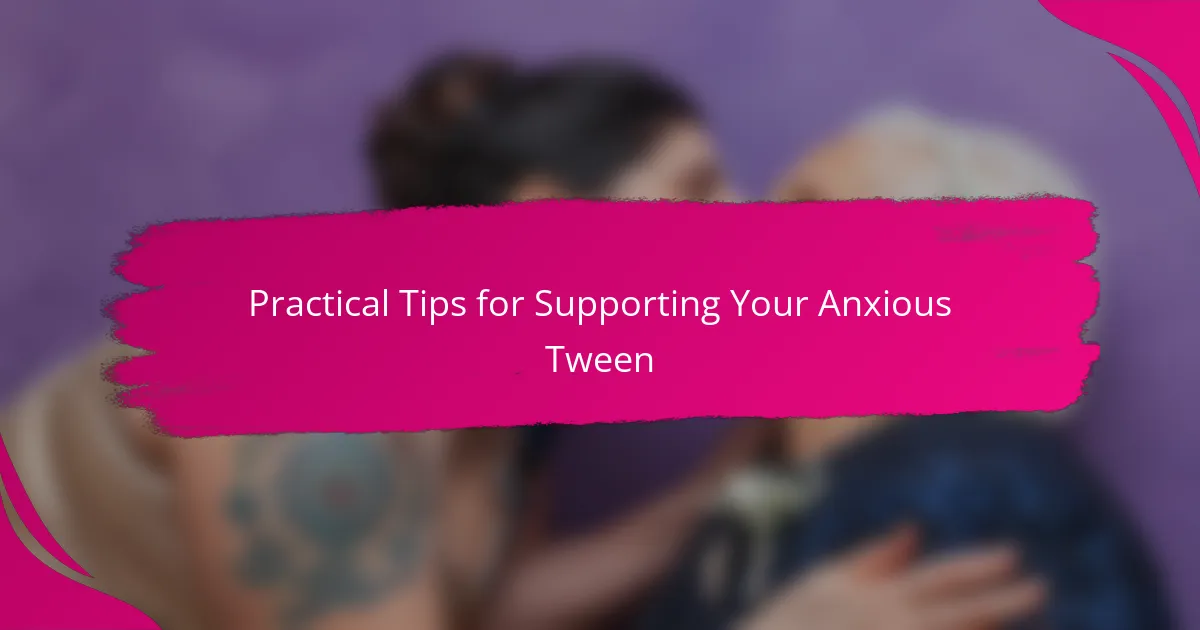
Practical Tips for Supporting Your Anxious Tween
One thing I found invaluable was keeping communication open but gentle. Instead of pressing my tween to “talk now,” I let them know I was always there when they were ready. Have you ever noticed how patience can sometimes be the quietest, yet most powerful kind of support?
I also learned the importance of helping my child build a toolbox of calming techniques. We experimented with deep breathing, squeezing a stress ball, or even short walks when anxiety spiked. It amazed me how these small, practical actions gave my tween a sense of control amid overwhelming feelings.
Finally, checking in regularly without making it feel like a formal “therapy session” helped maintain trust. Casual conversations during car rides or bedtime chats became moments where worries surfaced naturally. What ways have you found that make your tween feel safe enough to share without pressure? For me, creating low-stakes opportunities to connect made all the difference.
